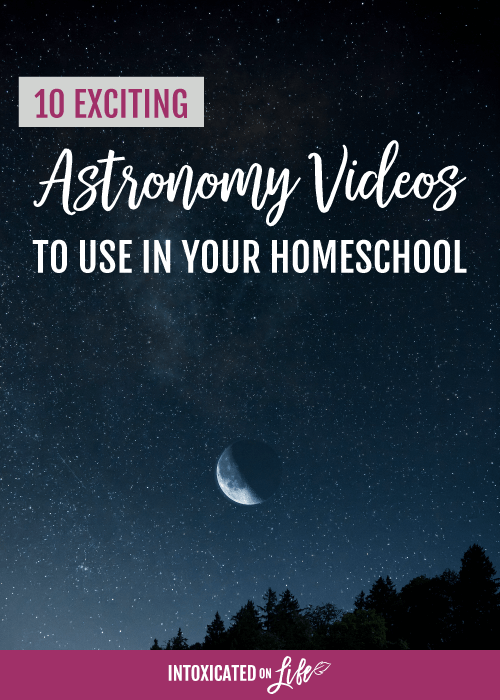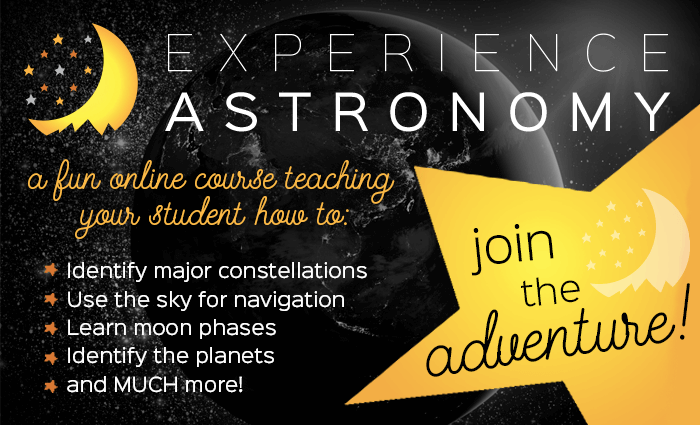
I love astronomy—and as a homeschooling dad, I love getting my kids excited about astronomy, too. I’ve taught astronomy to kids in our local homeschool co-op at all different grade levels, and I’ve taught over a thousand kids astronomy in my online courses.
Because astronomy is a visual discipline, I use a lot of astronomy videos when I teach. If you’re looking to teach your kids astronomy, these astronomy videos were some of my students’ favorites over the years.
Under each astronomy video, I’ve put a quiz question. Watch these videos with your kids and see if they know the answers to the questions! (Answers are at the bottom of the article.)
Astronomy Video #1: How do you find north?
As the earth rotates on its axis, the stars appear to move through the sky throughout the night. But there’s one star in the northern hemisphere that doesn’t appear to move. Below is a video that explains what the “north star” is—and why it always hasn’t been the north star.
Astronomy Video #2: Auroras: The Northern and Southern Lights
“Aurora” is Latin for “sunrise.” Over both Northern and Southern magnetic poles, these mysterious light displays have inspired people for centuries. These videos explain what causes them.
3. Homeschool Astronomy Video #3: Lake Ontario on Titan
The moon Titan has liquid methane lakes—the only object in the solar system, other than Earth, where liquid lakes are confirmed to exist. This one, called “Ontario Lacus” (Lake Ontario), was observed by the NASA spacecraft Cassini.
Video #4: How many stars can you see in the sky?
Just how many stars could you count in the sky? That depends on what you mean by “stars.” As far as individual stars go, you could count thousands if you didn’t use any telescopes. But there are far more up there than that?
Astronomy Video #5: Total Solar Eclipse
The sun is about 400 times bigger than the moon, but the moon is 400 times closer to the earth than the sun is, meaning they appear about the same size in the sky. At times the moon will line up with the disk of the sun in the sky, resulting in a total solar eclipse.
Video #6: Comet Collides with Jupiter
In July 1994, the world watched as a comet, Shoemaker-Levy 9, broke into many pieces and crashed into the planet Jupiter. The impacts of each piece could be seen from telescopes on Earth.
Homeschool Astronomy Video #7: Teddy in Space
This is a fun astronomy video about an elementary school class that sent a teddy bear into space using a weather balloon.
Video #8: The Solar System to Scale
Nearly every model of the solar system you’ve seen is totally wrong. If you make a model of the solar system to scale, you’d need to make it very, very large (otherwise your planets would be way too small to see). That’s what this video is all about. (If you want to make your own model of the solar system, here’s how to do it.)
Video #9: What do Jesus and the planet Venus have in common?
In Revelation 22:16 is the last thing Jesus says about himself in the whole Bible. Oddly, his statement has to do with the planet Venus. What gives?
Homeschool Astronomy Video #10: Planets, Sun, and Stars: A Comparison of Sizes
This astronomy video is by far one of my kid’s favorite videos. It shows the relative sizes of planets, the sun, and other stars in our galaxy.

Answers to Quiz Questions
1. The North Star is called Polaris. It doesn’t move because our North Pole points right at it. (Picture standing under an umbrella, spinning it around. The center of the umbrella won’t appear to turn.)
2. Auroras are caused by plasma from a solar storm leaving the sun and coming to Earth. While our planet’s magnetic field deflects most of the storm, gases enter the atmosphere over the earth’s poles to create beautiful light displays in the sky.
3. Titan is the largest moon of Saturn. It is larger than even the planet Mercury.
4. You can count 9,096 stars with the naked eye.
5. True. A New Moon is the phase of the moon where the lit up side of the moon is facing away from the earth.
6. A comet would destroy all or nearly all life on the planet.
7. A high altitude weather balloon can go up into space about 30 km (about 18.6 miles). In order to get up to the Kármán line, the commonly accepted boundary line between the earth’s atmosphere and outer space, we need to go up about 100 km (62 miles).
8. If the Earth was the size of a marble, you would need a circle 7 miles in diameter to fit all 8 planets going around the sun.
9. Venus is often called the “morning star” because, for about 263 days at a time, Venus rises in the morning before the sun rises.
10. The largest planet in this video is Jupiter—the largest planet in our solar system. The largest star in this video is the black hole inside TON 618. It is the largest known black hole in the universe.
Your Kids Can Learn Astronomy!
If your child loves learning about the stars, they will love Experience Astronomy.
We cover so much in these full-school-year online courses. Students learn about…
- How to identify major constellations
- Ways astronomy connects to fascinating stories in history, literature, folklore, archaeology, and the Bible
- The amazing world of interstellar space—stars, galaxies, black holes, and exoplanets
- How ancient people used astronomy to tell time, create calendars, and navigate the globe
Best yet: I do all the teaching for you through fun, engaging online Astronomy videos and hands-on activities.

